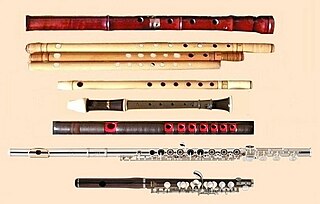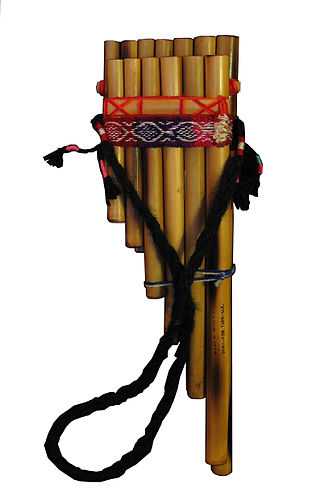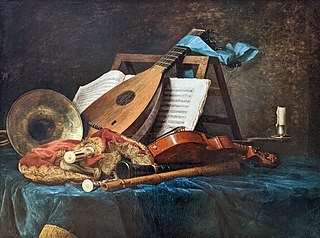In Greek mythology, Syrinx was a nymph who was transformed into water reeds that were then fashioned into a musical instrument by the god Pan.
Contents
Syrinx may also refer to:
In Greek mythology, Syrinx was a nymph who was transformed into water reeds that were then fashioned into a musical instrument by the god Pan.
Syrinx may also refer to:

The flute is a member of a family of musical instruments in the woodwind group. Like all woodwinds, flutes are aerophones, producing sound with a vibrating column of air. Unlike woodwind instruments with reeds, a flute produces sound when the player's air flows across an opening. In the Hornbostel–Sachs classification system, flutes are edge-blown aerophones. A musician who plays the flute is called a flautist or flutist.
Pipe(s), PIPE(S) or piping may refer to:

A pan flute is a musical instrument based on the principle of the closed tube, consisting of multiple pipes of gradually increasing length. Multiple varieties of pan flutes have been popular as folk instruments. The pipes are typically made from bamboo, giant cane, or local reeds. Other materials include wood, plastic, metal, and clay.

In classical Greek mythology, Syrinx was an Arcadian nymph and a follower of Artemis, known for her chastity. Being pursued by Pan, she fled into the river Ladon, and at her own request was metamorphosed into a reed from which Pan then made his panpipes.

The ney, is an end-blown flute that figures prominently in Egyptian Music, Persian music, Turkish music, Jewish music and Arabic music. In some of these musical traditions, it is the only wind instrument used. The ney has been played continually for 4,500–5,000 years, dating back to ancient Egypt, making it one of the oldest musical instruments still in use.

Daphnis et Chloé is a 1912 symphonie chorégraphique, or choreographic symphony, for orchestra and wordless chorus by Maurice Ravel. It is in three main sections, or parties, and a dozen scenes, most of them dances, and lasts just under an hour, making it the composer's longest work. In effect it is a ballet, and it was first presented as such. But it is more frequently given as a concert work, either complete or excerpted, vindicating Ravel's own description above.

Reed is a common name for several tall, grass-like plants of wetlands.
Bass or Basses may refer to:
Syrinx, L. 129, is a piece of music for solo flute which Claude Debussy wrote in 1913. It generally takes three minutes or less to perform. It was the first significant piece for solo flute after the Sonata in A minor composed by C. P. E. Bach over 150 years before (1747), and it is the first such solo composition for the modern Böhm flute, developed in 1847.

John Mills-Cockell is a Canadian composer and multi-instrumentalist, perhaps best known for his ground-breaking work with progressive / avant garde Canadian groups Intersystems and Syrinx, and for his numerous works for radio, television, film, ballet, and stage.
Prehistoric music is a term in the history of music for all music produced in preliterate cultures (prehistory), beginning somewhere in very late geological history. Prehistoric music is followed by ancient music in different parts of the world, but still exists in isolated areas. However, it is more common to refer to the "prehistoric" music which still survives as folk, indigenous or traditional music. Prehistoric music is studied alongside other periods within music archaeology.

Music was almost universally present in ancient Greek society, from marriages, funerals, and religious ceremonies to theatre, folk music, and the ballad-like reciting of epic poetry. This played an integral role in the lives of ancient Greeks. There are some fragments of actual Greek musical notation, many literary references, depictions on ceramics and relevant archaeological remains, such that some things can be known—or reasonably surmised—about what the music sounded like, the general role of music in society, the economics of music, the importance of a professional caste of musicians, etc.
Pan flute or pan pipe is an ancient musical instrument.
Joueurs de flûte, Op. 27, is a set of four pieces for flute and piano by the French composer Albert Roussel. It is the most popular of Roussel's works for the flute.

A musical instrument is a device created or adapted to make musical sounds. In principle, any object that produces sound can be considered a musical instrument—it is through purpose that the object becomes a musical instrument. A person who plays a musical instrument is known as an instrumentalist. The history of musical instruments dates to the beginnings of human culture. Early musical instruments may have been used for rituals, such as a horn to signal success on the hunt, or a drum in a religious ceremony. Cultures eventually developed composition and performance of melodies for entertainment. Musical instruments evolved in step with changing applications and technologies.
Simion Stanciu, also known by his stage-name Syrinx, was a Romanian Pan flute player and composer, who lived and worked in Switzerland.
Carl Nielsen's Pan and Syrinx is a symphonic poem written for a concert of the composer's works which was held on 11 February 1918 in Copenhagen.

Taonga pūoro are the traditional musical instruments of the Māori people of New Zealand.
Greek musical instruments were grouped under the general term "all developments from the original construction of a tortoise shell with two branching horns, having also a cross piece to which the stringser from an original three to ten or even more in the later period, like the Byzantine era". Greek musical instruments can be classified into the following categories:

Bamboo's natural hollow form makes it an obvious choice for many musical instruments. In South and South East Asia, traditional uses of bamboo the instrument include various types of woodwind instruments, such as flutes, and devices like xylophones and organs, which require resonating sections. In some traditional instruments bamboo is the primary material, while others combine bamboo with other materials such as wood and leather.